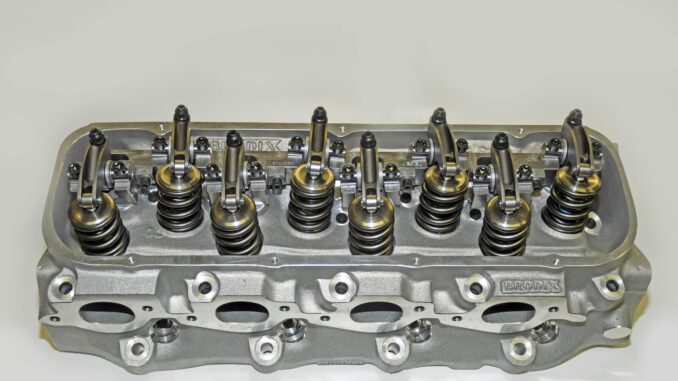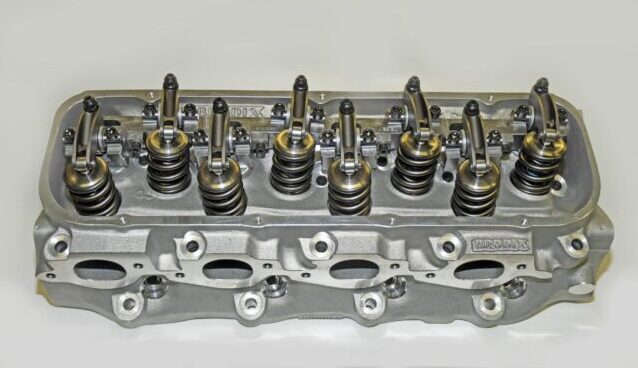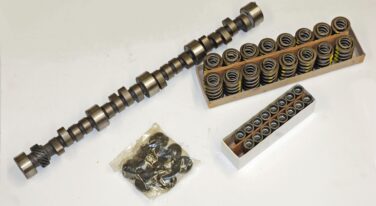
JESEL’S New Steel Sportsman Rockers – Part 2
In the past issue (see Part 1, we took a look at Jesel’s new steel Sportsman rocker. If you recall, it’s a new steel design based upon their very successful Sportsman (aluminum) lineup. Because of that, the new rockers still offer all of the benefits of their predecessors including optimized geometry, less friction in operation, easy valve lash and more. While the steel rocker body is slightly heavier, careful attention to detail results in minimal increases in the Mass Moment of Inertia. At the same time, the use of a premium tool steel for the body improves durability – particularly in endurance or boat applications or where forced induction enters the equation.
Something we’ve mentioned before but never really dug into is rocker geometry. Jesel defines rocker geometry this way: “Rocker geometry is a function of the arc generated from the rocker arm and the relationship of the valve tip to rocker shaft height. Using this arc correctly is the difference between a smooth operating valvetrain and a valvetrain of worn out parts. Jesel’s Low Pivot geometry utilizes the portion of the arc that produces a minimal sweep pattern from half to full lift, a point at which spring pressures are exponentially increasing. These added spring forces transferred against the nose roller have the potential to cause the roller to skid instead of roll across the tip bending the valve stem and wearing the guides. By minimizing the roller travel distance under high spring loads, the potential of roller skidding is reduced and valve guide wear is decreased tremendously.”
As you might have guessed, Jesel offers shaft rockers with all sorts of different ratios. The distance between the pushrod cup, the rocker shaft centerline and the roller tip determine the ratio of a rocker arm. In a shaft rocker setup, various pivot lengths can accept a big range of ratios from (approximately) 1.4:1 through to 2.25:1. That wide range of ratios simply isn’t practical (or possible in many cases) in a stud mount rocker. Increased rocker ratio is an important performance tool! It should be no surprise to anyone reading this that using a rocker arm to increase valve lift has its benefits. When you use the rocker arm to change lift figures, then you have access to an almost infinite means to fine-tune the valve train on a per-cylinder or per-valve basis. Bottom line here is, it’s a whole bunch easier to swap rockers than it is to swap complete camshafts.
When it comes to mounting, Jesel has several different systems available and they’re all dependent upon the cylinder head configuration. Many big block heads (using a stock style rocker boss arrangement on the head casting) can use a simple Sportsman Series Stand Link from Jesel. This patented stand link, ( U.S. Patent 7,028,653 B2 ) orientates the CNC machined steel rocker stands and aligns the rocker roller squarely with the valve tip. The stand link also acts as a safety guide in the event of a loose bolt. Other Jesel systems (such as the one found on the Brodix BB-3 Xtra heads shown in the photos make use of a one piece intake stand along with individual exhaust rocker stands. With this setup, the exhaust stands are tied to the intake stand by way of Allen-head fasteners. This, along with a heavy-duty Torx head fastener that bolts to the original rocker stud threads creates an extremely stiff mounting platform for the rockers. Of course, different head combinations dictate different rocker mounting arrangements. All are robust and designed to ensure the rocker pedestal is securely attached to the cylinder head.
One thing you should know about stands is that they are designed so that they can be shimmed. This compensates for a stand that is low on the cylinder head. For example, with the BB3 Xtra setup shown in the accompanying photos, Jesel includes three sets of different thickness shims with the shaft rocker kit.
What’s the right way to set lash? If you check the accompanying photos, you can see a special lash adjuster tool available from Jesel. Here’s Jesel’s take on the process: “Starting at #1 cylinder, rotate the engine until the #1 exhaust rocker just starts to open the exhaust valve. Set the valve lash on #1 intake rocker at this time. Continue rotating the assembly and stop when #1 intake rocker starts returning from full lift. The lash on #1 exhaust can now be set. Continue this procedure for the remaining cylinders following the engines firing order.”
Further to this, Jesel does not recommend running the adjuster turned out more than two revolutions from the fully seated position (the operating range of the lash adjuster is ¼ to 2 turns out from the seated position). All rockers shipped from Jesel with the adjuster set at one full turn from seated. Operating an engine with the adjusters more than two turns out puts excessive loads on the cup area and it might lead to premature failure of the adjuster. If the adjuster is less than ¼ turn from the seated position, use a shorter pushrod. Never modify the adjuster counterbore to compensate for a pushrod that is too long!
Finally, Jesel recommends you torque the adjuster: “We highly recommend using a torque wrench when setting valve lash. Our recommended torque setting for a typical 3/8-24 cup or ball style adjuster is 26 Lbs-Ft. Over tightening the adjuster nut stresses the thread area in the rocker body leading to premature rocker arm failure.”
As you can see, the new steel Sportsman shaft rocker setup from the folks at Jesel is an extremely high quality race component (engine jewelry once you look closely). If you have a need for rockers in an endurance or boosted application or extreme spring pressure application, look no further. And for a better look, check out the accompanying slideshow:
Click Here to Begin Slideshow
Something we’ve mentioned before but never really dug into is rocker geometry. Jesel defines rocker geometry this way: “Rocker geometry is a function of the arc generated from the rocker arm and the relationship of the valve tip to rocker shaft height. Using this arc correctly is the difference between a smooth operating valvetrain and a valvetrain of worn out parts. Jesel’s Low Pivot geometry utilizes the portion of the arc that produces a minimal sweep pattern from half to full lift, a point at which spring pressures are exponentially increasing. These added spring forces transferred against the nose roller have the potential to cause the roller to skid instead of roll across the tip bending the valve stem and wearing the guides. By minimizing the roller travel distance under high spring loads, the potential of roller skidding is reduced and valve guide wear is decreased tremendously.”
As you might have guessed, Jesel offers shaft rockers with all sorts of different ratios. The distance between the pushrod cup, the rocker shaft centerline and the roller tip determine the ratio of a rocker arm. In a shaft rocker setup, various pivot lengths can accept a big range of ratios from (approximately) 1.4:1 through to 2.25:1. That wide range of ratios simply isn’t practical (or possible in many cases) in a stud mount rocker. Increased rocker ratio is an important performance tool! It should be no surprise to anyone reading this that using a rocker arm to increase valve lift has its benefits. When you use the rocker arm to change lift figures, then you have access to an almost infinite means to fine-tune the valve train on a per-cylinder or per-valve basis. Bottom line here is, it’s a whole bunch easier to swap rockers than it is to swap complete camshafts.
When it comes to mounting, Jesel has several different systems available and they’re all dependent upon the cylinder head configuration. Many big block heads (using a stock style rocker boss arrangement on the head casting) can use a simple Sportsman Series Stand Link from Jesel. This patented stand link, ( U.S. Patent 7,028,653 B2 ) orientates the CNC machined steel rocker stands and aligns the rocker roller squarely with the valve tip. The stand link also acts as a safety guide in the event of a loose bolt. Other Jesel systems (such as the one found on the Brodix BB-3 Xtra heads shown in the photos make use of a one piece intake stand along with individual exhaust rocker stands. With this setup, the exhaust stands are tied to the intake stand by way of Allen-head fasteners. This, along with a heavy-duty Torx head fastener that bolts to the original rocker stud threads creates an extremely stiff mounting platform for the rockers. Of course, different head combinations dictate different rocker mounting arrangements. All are robust and designed to ensure the rocker pedestal is securely attached to the cylinder head.
One thing you should know about stands is that they are designed so that they can be shimmed. This compensates for a stand that is low on the cylinder head. For example, with the BB3 Xtra setup shown in the accompanying photos, Jesel includes three sets of different thickness shims with the shaft rocker kit.
What’s the right way to set lash? If you check the accompanying photos, you can see a special lash adjuster tool available from Jesel. Here’s Jesel’s take on the process: “Starting at #1 cylinder, rotate the engine until the #1 exhaust rocker just starts to open the exhaust valve. Set the valve lash on #1 intake rocker at this time. Continue rotating the assembly and stop when #1 intake rocker starts returning from full lift. The lash on #1 exhaust can now be set. Continue this procedure for the remaining cylinders following the engines firing order.”
Further to this, Jesel does not recommend running the adjuster turned out more than two revolutions from the fully seated position (the operating range of the lash adjuster is ¼ to 2 turns out from the seated position). All rockers shipped from Jesel with the adjuster set at one full turn from seated. Operating an engine with the adjusters more than two turns out puts excessive loads on the cup area and it might lead to premature failure of the adjuster. If the adjuster is less than ¼ turn from the seated position, use a shorter pushrod. Never modify the adjuster counterbore to compensate for a pushrod that is too long!
Finally, Jesel recommends you torque the adjuster: “We highly recommend using a torque wrench when setting valve lash. Our recommended torque setting for a typical 3/8-24 cup or ball style adjuster is 26 Lbs-Ft. Over tightening the adjuster nut stresses the thread area in the rocker body leading to premature rocker arm failure.”
As you can see, the new steel Sportsman shaft rocker setup from the folks at Jesel is an extremely high quality race component (engine jewelry once you look closely). If you have a need for rockers in an endurance or boosted application or extreme spring pressure application, look no further. And for a better look, check out the accompanying slideshow:
Click Here to Begin Slideshow




![[Gallery] Okolona Street Rods Kentuckiana V Foundation Car Show](https://www.racingjunk.com/news/wp-content/uploads/2022/04/IMG_0774-e1650040587750-376x206.jpg)
![[Gallery] Road Rats Car Show](https://www.racingjunk.com/news/wp-content/uploads/2022/05/2A-e1651770667920-376x206.jpg)

Leave a Reply